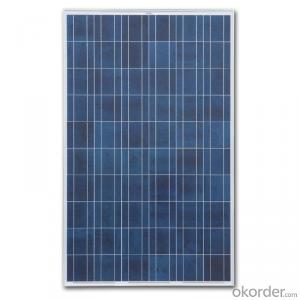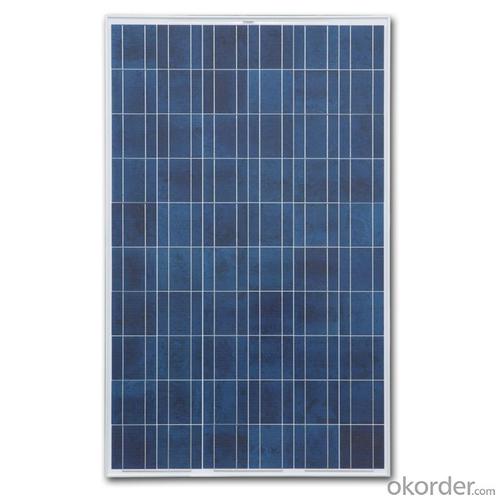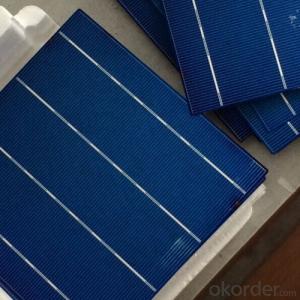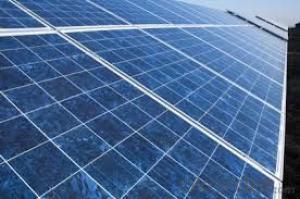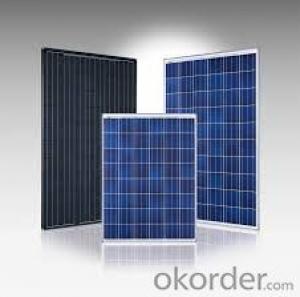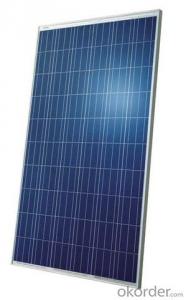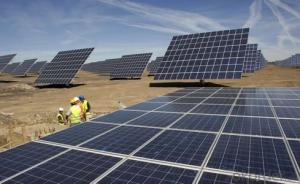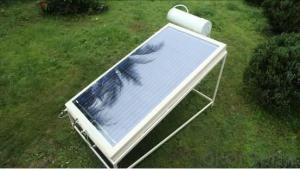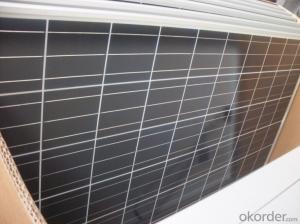Crystalline Si Solar Cells - Factory Wholesale Polycrystalline Solar Panel CNBM
- Loading Port:
- Qingdao
- Payment Terms:
- TT OR LC
- Min Order Qty:
- 10 set
- Supply Capability:
- 300000 set/month
OKorder Service Pledge
OKorder Financial Service
You Might Also Like
Polycrystalline Solar Modules
CNBM offers a range of small, medium and large polycrystalline solar modules, designed for a range of requirements.
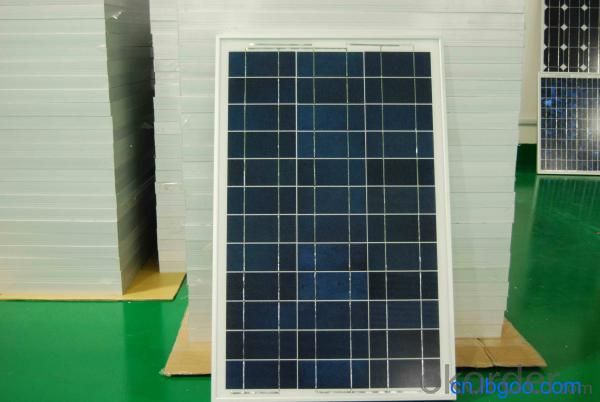
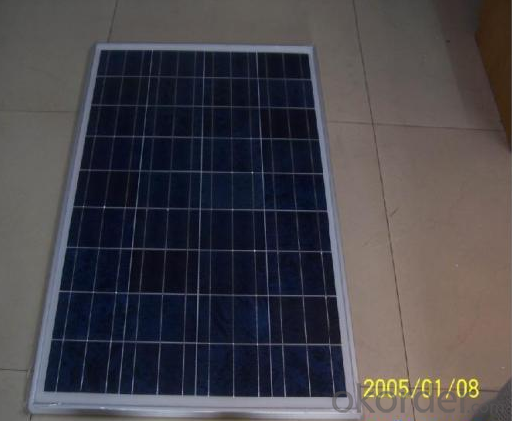
Specifications:
Tolerance | +/-3% |
Cell | Polycrystalline silicon solar cells (156 x 156mm) |
N0. of Cells | 60 (0 x 6) |
Dimension of Modules (mm) | 1650 x 990 x 40 |
Weight (kg) | 25.5 |
Limits:
Operating Temperature | -40~+85? |
Storage Temperature | -40~+85? |
Maximum System Voltage | 1000 VDC max. |
Hail Impact | Diameter of 28mm with impact speed |
Temperature and Coefficients:
NOCT | 48C+/-2? |
Voltage temperature coefficient (%/K) | -0.35 |
Current temperature coefficient (%/K) | 0.05 |
Power temperature coefficient (%/K) | -0.45 |
Characteristics:
Model: | SGM-200P | SGM-210P | SGM-220P |
Max-power voltage Vmp (V) | 29.2 | 29.4 | 29.41 |
Max-power current Imp (A) | 6.85 | 7.14 | 7.48 |
Open-circuit voltage Voc (V) | 36.5 | 36.69 | 36.9 |
Short-Circuit Current Isc (A) | 7.28 | 7.6 | 7.93 |
Max-power Pm(W) | 200 | 210 | 220 |
Model: | SGM-230P |
Max-power voltage Vmp (V) | 29.8 |
Max-power current Imp (A) | 7.72 |
Open-circuit voltage Voc (V) | 37.31 |
Short-Circuit Current Isc (A) | 8.19 |
Max-power Pm(W) | 230 |
STC: Irradiance 1000W/m2, module temperature 25?, AM-=1.5
Poly Crystalline Solar Panels Specifications Range
Maximum Power (Pm) | Dimension | Weight | Operating Voltage (Vmp) | Operating Current (Imp) | Open Circuit Voltage (Voc) | Short Circuit Current (Isc) |
0.45W | 140x80x10mm | 0.08kg | 3.3V | 150mA | 4.6V | 160mA |
1.0W | 162x140x10mm | 0.16kg | 7.5V | 150mA | 10.3V | 160mA |
4.5W | 269x251x23mm | 0.8kg | 16.5V | 0.27A | 20.5V | 0.3A |
10W | 420.1×268.9×22.6mm | 1.92kg | 17.5V | 0.58A | 20.5V | 0.6A |
20W | 425x502x50mm | 3.0kg | 16.8V | 1.19A | 21.0V | 1.29A |
30W | 593x502x22.6mm | 3.9kg | 16.8V | 1.78A | 21.0V | 1.94A |
40W | 655x537x50mm | 5.75kg | 17.3V | 2.31A | 22.1V | 2.54A |
50W | 839x537x50mm | 6.0kg | 17.5V | 2.9A | 21.8V | 3.17A |
65W | 1111x502x50mm | 7.2kg | 17.6V | 3.69A | 22.1V | 3.99A |
80W | 1204x537x50mm | 7.7kg | 17.6V | 4.55A | 22.1V | 4.8A |
- Q: What materials are commonly used in solar cells?
- Commonly used materials in solar cells include silicon, which is the most widely used material in photovoltaic cells, as well as thin-film materials such as cadmium telluride (CdTe), copper indium gallium selenide (CIGS), and amorphous silicon (a-Si). Other materials like perovskite and organic materials are also being researched and developed for solar cell applications.
- Q: What can be used as the materials for solar cells?
- EVA.
- Q: How do solar cells perform in cloudy or overcast conditions?
- Solar cells are less efficient in cloudy or overcast conditions compared to direct sunlight. Cloud cover reduces the amount of sunlight reaching the solar cells, resulting in decreased electricity production. However, solar cells can still generate some energy in these conditions, although at a reduced rate.
- Q: Can solar cells be used to power street lights?
- Yes, solar cells can be used to power street lights. Solar-powered street lights utilize photovoltaic panels to convert sunlight into electricity, which is then stored in batteries. This stored energy is used to power the street lights during the night, providing an eco-friendly and cost-effective lighting solution for public spaces.
- Q: Can a solar cell be used in commercial buildings?
- Yes, of course, it can .
- Q: Can solar cells be used in vehicles?
- Yes, solar cells can be used in vehicles. They can be integrated into the design of cars, buses, boats, and even airplanes to convert sunlight into electricity, providing power for various vehicle functions such as charging batteries, running onboard systems, or even powering the entire vehicle.
- Q: Is the Photovoltaic Cells cheap to buy?
- Compared to the other product which can generate the power, the Photovoltaic Cells are not cheap at all. However, if you take a look at all the solar cells product in the market, Photovoltaic Cells are actually comsidered to be cheap.
- Q: How do solar cells handle power fluctuations?
- Solar cells handle power fluctuations by using a device called an inverter. The inverter converts the direct current (DC) produced by the solar cells into alternating current (AC) that is suitable for use in homes and businesses. It also helps to regulate and stabilize the power output, ensuring a consistent and steady flow of electricity despite any fluctuations in sunlight intensity or changes in load demand.
- Q: Can solar cells be used in space exploration?
- Yes, solar cells can be used in space exploration. Solar cells are commonly used to power spacecraft and satellites in space missions. They convert sunlight into electricity, providing a reliable and renewable source of power for various systems and equipment used in space exploration.
- Q: Can solar cells be used in healthcare facilities?
- Yes, solar cells can be used in healthcare facilities. They can help power various equipment and devices, such as lighting, ventilation systems, and medical equipment, reducing reliance on traditional energy sources and lowering operational costs. Additionally, solar power can be utilized in remote and off-grid healthcare facilities, ensuring access to clean and sustainable energy for essential healthcare services.
Send your message to us
Crystalline Si Solar Cells - Factory Wholesale Polycrystalline Solar Panel CNBM
- Loading Port:
- Qingdao
- Payment Terms:
- TT OR LC
- Min Order Qty:
- 10 set
- Supply Capability:
- 300000 set/month
OKorder Service Pledge
OKorder Financial Service
Similar products
Hot products
Hot Searches
Related keywords
